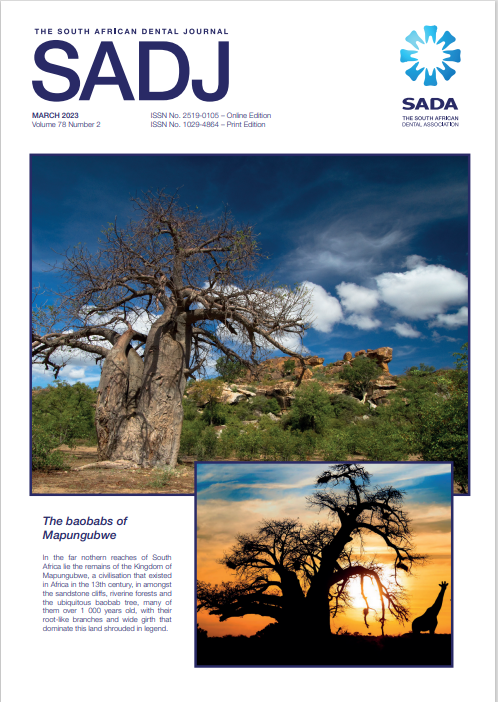Proteus Syndrome – A one in a million occurrence
DOI:
https://doi.org/10.17159/sadj.v78i02.16144Keywords:
Proteus syndrome; craniofacial deformity; AKT1 gene mutationAbstract
The syndrome is named after the Greek sea-god Proteus, who could change his shape. Proteus Syndrome (PS) is a rare condition with an incidence of less than 1 in 1 million people. It is characterized by variable, multifocal overgrowth of bones, skin, or other tissue derived from any of the three germinal layers. It is generally not apparent at birth, but signs develop rapidly from as early as 6 months and get more severe with age. Craniofacial deformities are less frequent but overgrowth of facial bones leads to disfigurement, malocclusion and a number of other oral and dental anomalies. The following case report of a young boy with PS was written for three reasons. Firstly, it will describe this unusual condition to colleagues who have never encountered patients with the syndrome. It then stresses the importance of a holistic approach to treatment planning. This entails addressing the immediate needs, and then basing the definitive treatment on considerations of possible short- and long term, patient-related developments. Finally, it illustrates how a complex case was treated successfully with conservative management using modifications of standard clinical procedures.
Downloads
References
Biesecker L. The challenges of Proteus Syndrome: Diagnosis and management. Eu J Hum Genet; 2006. 14(11):1151-7. DOI: https://doi.org/10.1038/sj.ejhg.5201638
Jamis-Dow CA., Turner J, Biesecker LG and Choyke PL. Radiologic manifestations of Proteus syndrome. Radiographics. 2004. Vol 23(4):1051-1068. DOI: https://doi.org/10.1148/rg.244035726
Cohen MJ. 2005. Proteus Syndrome: An Update. Am J of Med Genet; 137C:38-52 DOI: https://doi.org/10.1002/ajmg.c.30063
Mun Munhoz L, Arita ES, Nishimura DA, et al,. Maxillofacial manifestations of Proteus syndrome: a systemic review with a case report. Oral Radiol.2021. 37: 2-12. DOI: https://doi.org/10.1007/s11282-019-00416-y
Biesecker LG, Happle R, Mulliken JB, et al,. Proteus syndrome: diagnostic criteria, differential diagnosis, and patient evaluation. Am J Med Genet.1999 Jun 11;84(5):389-95. Review. DOI: https://doi.org/10.1002/(SICI)1096-8628(19990611)84:5<389::AID-AJMG1>3.0.CO;2-O
Misch CE, Goodacre CJ, Finley JM, et al,. Consensus conference panel report: crown-height space guidelines for implant dentistry-part 1. Implant dentistry. 2005;14(4):312-318. DOI: https://doi.org/10.1097/01.id.0000188375.76066.23
Tosi LL, Sapp JC, Allen ES, O’Keefe RJ, et al,. Assessment and management of the orthopedic and other complications of Proteus syndrome. J Children’s Ortho: Official J of Eur Paed Orthopaedic Soc (epos). 2011;5(5):319-327. doi:10.1007/s11832-011-0350-6 DOI: https://doi.org/10.1007/s11832-011-0350-6
Downloads
Published
Issue
Section
License

This work is licensed under a Creative Commons Attribution-NonCommercial 4.0 International License.





.png)